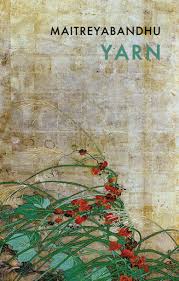Yarn
 Already a well-known figure in Britain”s Buddhist community, Maitreyabandhu founded Poetry East in 2010, a venture which set about exploring the relationship between spiritual life and poetry. As a teacher of Buddhism and meditation at the London Buddhist Centre, he is better placed than most to explore this connection. Already a published author of several books on Buddhism, Maitreyabandhu’s debut collection, The Crumb Road was released by Bloodaxe in 2013 and is a Poetry Book Society recommendation.
Already a well-known figure in Britain”s Buddhist community, Maitreyabandhu founded Poetry East in 2010, a venture which set about exploring the relationship between spiritual life and poetry. As a teacher of Buddhism and meditation at the London Buddhist Centre, he is better placed than most to explore this connection. Already a published author of several books on Buddhism, Maitreyabandhu’s debut collection, The Crumb Road was released by Bloodaxe in 2013 and is a Poetry Book Society recommendation.
Yarn, his latest collection (Bloodaxe, 2015) is about the stories we tell. The cover, a Japanese screen print of rambling tendrils and delicate blooms is perhaps a clue to what lies within. Indeed, the OED definition of yarn – “a long or rambling story, especially one that is implausible” – is helpfully printed on the back. Already one is expecting a slightly complex, long-winded version of events.
It is a surprise then, to open the book and find so much white space. Revealingly, Maitreyabandhu has spoken at length about the way in which, as a poet, he arranges the words on the page. White space, he suggests, is symbolic of silence, and the poet must speak into that silence. The importance of the message can be found in the slowing down of the words. The white page is a receptive “dream space” rather than a “doing” space.
The index reveals a carefully- ordered collection in four sections, each with its own tone and subject matter. The first section “The Travellers from Orissa” is robustly spiritual, but written in a very accessible colloquial style. The second part is an extended sequence of elegies, both simple and reflective in tone and execution. “The Yard”, a memory of childhood, family and belonging, is nostalgic and somewhat quotidian. The final section, “And Always, Somewhere” features some gorgeously enigmatic prose compositions, such as “The Old Man and the Wood”, which might almost be described as an observation, so subtle is it in terms of delivery.
The collection hinges on three substantial dramatic monologues – “The Cattle Farmer”s Tale”, “The Travellers from Orissa” and “Aaron”s Brother”. Yet, many of the other poems are brief, modestly set out upon the page, and Maitreyabandhu’s attention to this white space, his determination to let the words breathe, makes for an intriguing and memorable reading. Take for example this fragment from “Souls”, a poignant meditation on an age-old question:
I don’t believe that souls are turned to birds.
Watch them on the lawn, the blackbirds stab
The muddy grass for worms.I don’t believe that souls transform to deer
that track us from a wood, remembering
their former human forms
The entire poem, just six three-line stanzas, is almost skeletal in form; the bare bones of our existential preoccupation, a half-chant to the unseen power which may hold all the answers. The evocative, sensual “In Collioure” receives a similar treatment:
His shield-like chest and back,
a perfect sand,
standing like a sailorin the gentle ebbing tide –
keep for us your pride,
your sea-wet hairand how the sun
once drew a line around
your arms and thighs,the angle of your jaw,
that first hot summer
in Collioure.
The very restraint of this composition is so expressive and highlights a certain lack of poetic ego. Indeed there is a modesty and a feeling of contemplation around this entire body of work that chimes deeply with Maitreyabandhu’s chosen path. The poetry is all the richer for this, and the reader all the more enriched.
Sandra Ireland

Leave a Reply